Accepted Scientific Name: Ferocactus peninsulae subs. santa-maria (Britton & Rose) Pilbeam & Bowdery
Ferocactus 82. 2005 Pilbeam
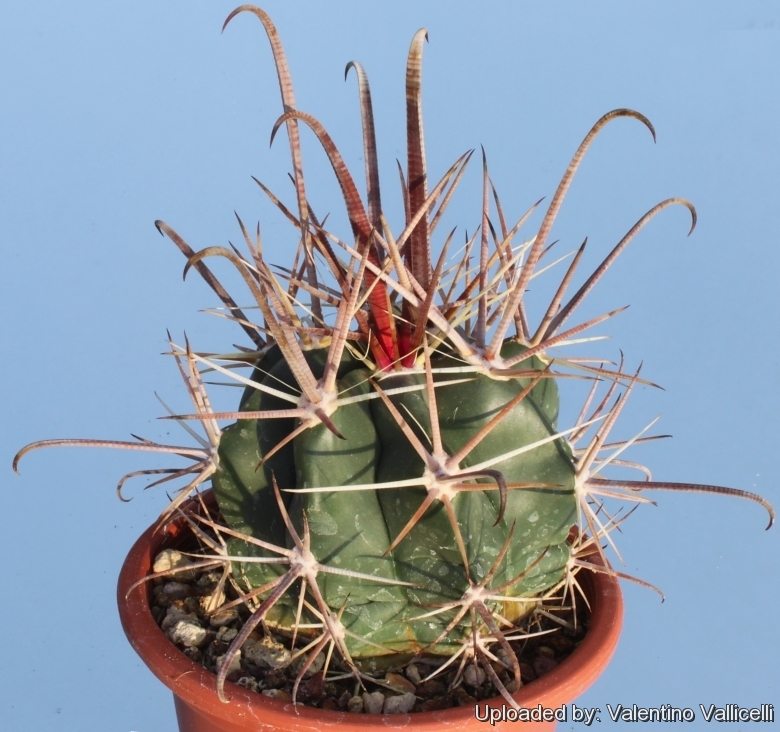
Ferocactus santa-maria (Ferocactus peninsulae subs. santa-maria) Photo by: Valentino Vallicelli
It is a beautiful plant with stout, fierce red spines.
Origin and Habitat: Mexico, southwest of the Baja California south, Santa Maria Bay, with San Carlos and Isla Magdalena.
Synonyms:
See all synonyms of Ferocactus peninsulae
Common Names include:
ENGLISH: Santa-Maria Barrel Cactus
Description: It is a massively spined barrel cactus, usually solitary. It is a close relative of Ferocactus peninsulaeSN|11977]]SN|11977]].
Stem: Spherical to shortly columnar, up to 75 cm high, and 25 cm wide.
Ribs: About 13, blunted, straight.
Areoles: Large, oval, 2 cm long and 12 mm wide, with yellow-brown felt.
Central spines: 4, quite straight and hooked up to 4.5 cm long, the lower three (middle) are the longest, flattened, sometimes curved at the apex..
Radial spines: About 15, the upper 12 bristle-like, light colored, the lower 3 look like the middle ones, and are often counted along with them, in which case the central spines are 7 and the radial 12
Flower: 3.5 to 6 cm long and 4 to 7 cm wide, yellow or straw-yellow with a pale-red center line on the petals, pleasant-smelling.
Blooming season: August-September.
Fruits: Yellow or yellowish green, fleshy, 2 to 5 cm long and 2 to 3,5 cm wide, with lasting Perianth. Fruit wall approx.. 3 mm thick, pulp extraordinarily juicy, at the beginning slimily, glassily, with fruity taste soon drying, fruit then opening by a basal pore.
Seeds: dark-brown or black, 2-2.5 mm long and 1.5 mm wide; Testa with a fine polygonal network;
Hilum small, approximately 0,5 mm in diameter.
Remarks: Areolar glands are found between the flower’s bud and the spine cluster in the flowering areoles.
More...Subspecies, varieties, forms and cultivars of plants belonging to the Ferocactus peninsulae/wislizenii complex
This Taxon has various synonyms whit several controversial varieties and subspecies and comprises a multitude of different forms, but where each form is linked to others by populations of plants with intermediate characteristics:
 Ferocactus gracilis H.E.Gates: (subsp. gracilis) has stems up to 1 m in tall and has central spines less than 5 mm wide.Distribution: northern central Baja California.
Ferocactus gracilis H.E.Gates: (subsp. gracilis) has stems up to 1 m in tall and has central spines less than 5 mm wide.Distribution: northern central Baja California. Ferocactus gracilis subs. coloratus (H.E.Gates) N.P.Taylor: Usually less than 1 m tall but the widest central spines often exceed 5 mm. Distribution: south of subspecies gracilis.
Ferocactus gracilis subs. coloratus (H.E.Gates) N.P.Taylor: Usually less than 1 m tall but the widest central spines often exceed 5 mm. Distribution: south of subspecies gracilis. Ferocactus gracilis subs. gatesii (G.E.Linds.) N.P.Taylor: Up to 1,5 m tall, and the central spines are curved but not hooked and only 3 mm wide. Distribution: Bahia de los Angeles in the gulf of California (Smith Islands group in the Sea of Cortez)
Ferocactus gracilis subs. gatesii (G.E.Linds.) N.P.Taylor: Up to 1,5 m tall, and the central spines are curved but not hooked and only 3 mm wide. Distribution: Bahia de los Angeles in the gulf of California (Smith Islands group in the Sea of Cortez)- Ferocactus horridus Britton & Rose
 Ferocactus peninsulae (F.A.C.Weber) Britton & Rose: (subsp. peninsulae) has 4 central spines, forming a cross. Principal central spine flattened and strongly hooked, flowers over 5 cm long, outer periant segments spatulate. Plant somewhat allways taller than broad. Distribution: Baja California.
Ferocactus peninsulae (F.A.C.Weber) Britton & Rose: (subsp. peninsulae) has 4 central spines, forming a cross. Principal central spine flattened and strongly hooked, flowers over 5 cm long, outer periant segments spatulate. Plant somewhat allways taller than broad. Distribution: Baja California. Ferocactus peninsulae f. brevispinus (Chinned type): has very odd chinned ribs.
Ferocactus peninsulae f. brevispinus (Chinned type): has very odd chinned ribs. Ferocactus peninsulae f. brevispinus cristatus hort.: Crested form.
Ferocactus peninsulae f. brevispinus cristatus hort.: Crested form. Ferocactus peninsulae f. brevispinus hort.: short spined form.
Ferocactus peninsulae f. brevispinus hort.: short spined form. Ferocactus peninsulae f. brevispinus cv. Artichoke: spineless form remembering in shape an Obregonia denegrii.
Ferocactus peninsulae f. brevispinus cv. Artichoke: spineless form remembering in shape an Obregonia denegrii. Ferocactus peninsulae subs. santa-maria (Britton & Rose) Pilbeam & Bowdery: has yellow flowers, principal central spine straight or slightly curved. Plant somewhat conical, taller than broad. Distribution: Southern Baja California.
Ferocactus peninsulae subs. santa-maria (Britton & Rose) Pilbeam & Bowdery: has yellow flowers, principal central spine straight or slightly curved. Plant somewhat conical, taller than broad. Distribution: Southern Baja California. Ferocactus peninsulae subs. townsendianus (Britton & Rose) Pilbeam & Bowdery: has orange or red flowers, principal central spine strongly hooked. Plant somewhat conical, taller than broad. Distribution: Baja California (Magdalena Plain, Santa Margarita, Magdalena Islands).
Ferocactus peninsulae subs. townsendianus (Britton & Rose) Pilbeam & Bowdery: has orange or red flowers, principal central spine strongly hooked. Plant somewhat conical, taller than broad. Distribution: Baja California (Magdalena Plain, Santa Margarita, Magdalena Islands). Ferocactus peninsulae subs. viscainensis (H.E.Gates) F.Wolf & R.Wolf: has 4 central spines, forming a cross. Plant to 1,5 m tall and 3 dm wide. Ribs 13-21. Distribution: Baja california norte.
Ferocactus peninsulae subs. viscainensis (H.E.Gates) F.Wolf & R.Wolf: has 4 central spines, forming a cross. Plant to 1,5 m tall and 3 dm wide. Ribs 13-21. Distribution: Baja california norte.
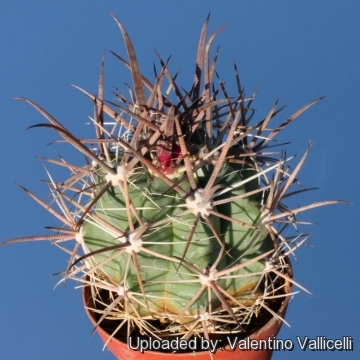 Ferocactus santa-maria (Ferocactus peninsulae subs. santa-maria) Photo by: Valentino Vallicelli
Ferocactus santa-maria (Ferocactus peninsulae subs. santa-maria) Photo by: Valentino Vallicelli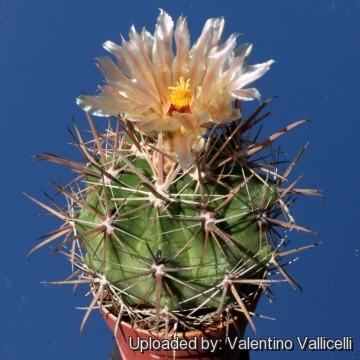 Ferocactus santa-maria (Ferocactus peninsulae subs. santa-maria) Photo by: Valentino Vallicelli
Ferocactus santa-maria (Ferocactus peninsulae subs. santa-maria) Photo by: Valentino Vallicelli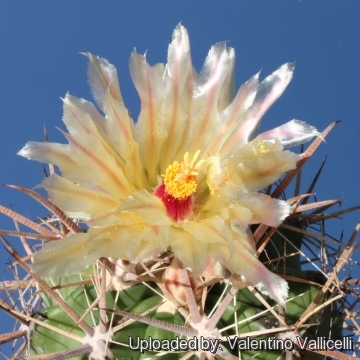 Ferocactus santa-maria (Ferocactus peninsulae subs. santa-maria) Photo by: Valentino Vallicelli
Ferocactus santa-maria (Ferocactus peninsulae subs. santa-maria) Photo by: Valentino Vallicelli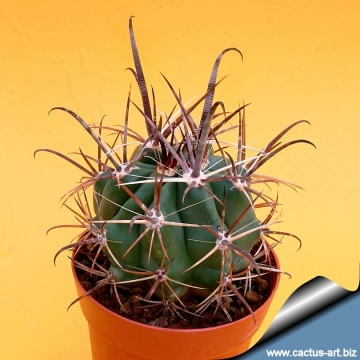 Ferocactus santa-maria (Ferocactus peninsulae subs. santa-maria) Photo by: Cactus Art
Ferocactus santa-maria (Ferocactus peninsulae subs. santa-maria) Photo by: Cactus Art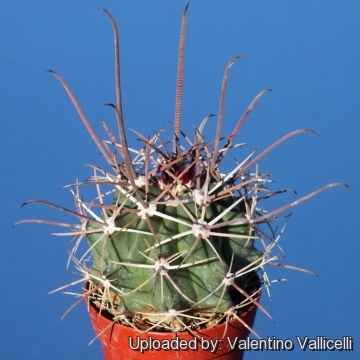 Ferocactus santa-maria (Ferocactus peninsulae subs. santa-maria) Photo by: Valentino Vallicelli
Ferocactus santa-maria (Ferocactus peninsulae subs. santa-maria) Photo by: Valentino Vallicelli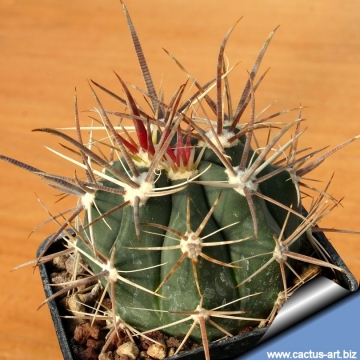 Ferocactus santa-maria (Ferocactus peninsulae subs. santa-maria) Photo by: Cactus Art
Ferocactus santa-maria (Ferocactus peninsulae subs. santa-maria) Photo by: Cactus Art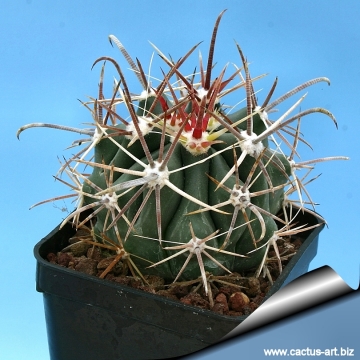 Ferocactus santa-maria (Ferocactus peninsulae subs. santa-maria) Photo by: Cactus Art
Ferocactus santa-maria (Ferocactus peninsulae subs. santa-maria) Photo by: Cactus ArtSend a photo of this plant.The gallery now contains thousands of pictures, however it is possible to do even more. We are, of course, seeking photos of species not yet shown in the gallery but not only that, we are also looking for better pictures than those already present.
Read More... Cultivation and Propagation: Slow growing to start, but it does well under cultivation. Use very draining soil, water during the aestival growth cycle (this plant need plenty of water). But it's necessary to avoid wetting the bodies of these plants while they are in sunlight. A wet cactus in the sun light can cause sun burning, which can lead to scars or even fungal infections and death.
Needs full sun. Keep dry at 10°C in winter, but it can tolerate sporadic light frost.
Propagation: Seeds are the only way of reproducing.


















